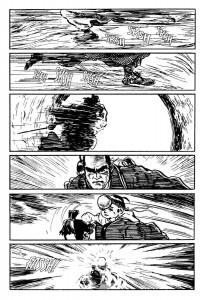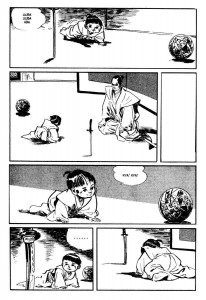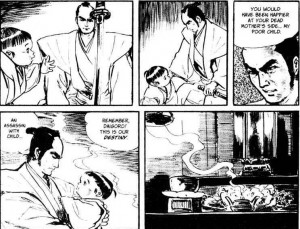Lone Wolf and Cub: The Assassin’s Road (Vol. 1)
Writer: Kazuo Koike
Artist: Goseki Kojima
I never read any manga as a kid. The closest I came to it was watching manga-based anime like Akira, so my impression of manga was that it was mainly about teenagers screaming at each other as they fought to the death (depending on the series, these battles might involve giant robots and/or cat-girls). And the manga digests were alien and weird, these thick, little books with black-and-white artwork.
Now I’m older and a little bit wiser, so I’ve decided to let go of my prejudices and see what all the fuss is about. But the sheer size of the manga industry, along with my total unfamiliarity with the major titles, has made it difficult to find a clear point of entry. And while I try to keep an open mind, I’m not quite ready to jump into yaoi. I’m sticking close to my comfort zone, which just so happens to include samurai.
Lone Wolf and Cub proved to be a great starting point. Set during the Tokugawa era, it depicts the adventures of the assassin Ogami Itto and his infant son Daigoro. The chapters in the first volume are episodic. Other than Itto and Daigoro, characters do not carry over from story to story. Also, each chapter tends to follow a simple formula: Itto arrives in some town or village pushing his son around in a cart, he toys with his target for a while, his target ineffectually tries to get rid of him, and Itto then kills his target and everyone who gets in his way. And occasionally, hot women remove their clothes.
Of course, there’s a downside to the episodic approach. Even having just read the volume, it’s hard to remember the specific details of any one story, and all the chapters feel vaguely indistinguishable. Like every procedural on television, enjoying Lone Wolf and Cub is contingent upon enjoying the repetition of particular themes and events. As someone who enjoys reading about samurai, I found the stories entertaining, but it’s easy to imagine someone with different tastes finding it to be a repetitive bore.
The art is actually the bigger selling point. Goseki Kojima’s style is heavily influenced by traditional Japanese artwork, and it’s absolutely perfect for the subject matter. He’s also a capable storyteller. Panels are attractive and uncluttered, spatial relationships are clear, and the panel layout ensures that the narrative is easy to follow. His talents are particularly evident during the fight scenes. Many Western comic artists have trouble creating the illusion of motion in a medium comprised of static images. Kojima is one of the few artists I’ve seen who can plot a fight scene so that actions that occur between panels are just as obvious as those depicted in the panels.
As these pages make clear, Itto is a sneaky bastard.
The various chapters touch upon themes that will be instantly familiar to fans of samurai stories (honor, self-sacrifice, bravery, etc.). But the most prominent theme throughout the entire volume is the devotion between father and son that survives even as Ogami Itto follows the “assassin’s road.” Itto clearly loves Daigoro, but at the same time Itto is an essentially violent man, and he chooses to work as an assassin as he plots his revenge on the men who disgraced him. His love for Daigoro is conditional on Daigoro being worthy to follow in his footsteps. In practice, this means that Itto frequently risks Daigoro’s life just as he risks his own life. The potential conflict between Itto’s profession and his love for his son never arises, however, because it’s clear from early on that Daigoro truly is his father’s son.
But for all its high-minded pretentions about honor and family devotion, Lone Wolf and Cub is overflowing with violence and sex. At first glance, the book seems to be an uneven combination of high-brow Eastern philosophy and low-brow exploitation. This is partially deliberate. Kazuo Koike no doubt intended to explore the contradiction between bushido ideals and the harsh reality of feudal Japan. But the book is also clearly nostalgic for an era when men were men. Ogami Itto is Koike’s ideal man: strong, relentless, sexually virile, and honorable in his own way (and ignoring all the times he risks his son’s life, he’s a loving father too). In Koike’s vision of feudal Japan, there is a natural coexistence of philosophy, ideals, violence, and sex because only in this era could men achieve both physical and spiritual perfection.
So Lone Wolf and Cub is retrogressive and occasionally quite sleazy. But I couldn’t help but enjoy it. I may be a bleeding heart, but I appreciate action stories with great art and clever plotting. Here’s my favorite panel of the entire volume:
A part of me is offended by how Itto is so unconcerned about Daigoro’s safety. But a much bigger part of me admires the badassery of killing 10 men while giving his son a piggyback ride.






You should definitely give Vagabond by Takehiko Inoue a look. It is a very impressive series, particularly the artwork.
This looks wonderful! I read an out-of-order volume years ago, but I don’t remember much. I’m going to go get this one.
Have you read Saiyuki? It’s my favorite manga of all time and explores buddhism and philosophy as well as wonderful action. The art is a teeny bit clunky in the first bit, but gets rolling along into sheer gorgeousness. It can’t really be read out of order, however.
I forgot to mention House of Five Leaves as well. Viz has been serializing it online, along with some other series, so it’s good way to check out some manga for free.
The repetitive episodic nature of Lone Wolf and Cub doesn’t last. They get much more involved with the larger story as the volumes continue on. I wrote a little about it here: http://madinkbeard.com/blog/archives/lone-wolf-and-akira
It’s well worth continuing with the series.
Eric- it’s funny that you mention Vagabond, because I just read a review of it yesterday and it caught my interest, so I’ll be sure to check it and “House of Five Leaves” out.
Vom- when I say that “Lone Wolf and Cub” is my entry point, I’m not kidding. It’s the first manga I’ve read so far. I haven’t read Saiyuki, but I’ll add the first volume to my reading list. Anything that combines action, philosophy, and gorgeous art is worth giving a try. And please keep the recommendations coming.
DerikB- thanks for the link. I enjoyed “Lone Wolf” enough to continue on, though with 28 volumes, I’ll probably take my time.
I just started reading Vagabond today. Got a great ebay deal on the first four Vizbig volumes (each containing 3 of the regular volumes).
(Actually, got the whole run of Lone Wolf on ebay for a really good price too.)
I don’t shop much on ebay. I tend to be a new book snob, which I know is stupid, but I can’t help it.
But in the case of a long running series like “Lone Wolf” it might make sense…
I love me some LW+C, but the small format makes it more difficult for me to enjoy the *amazing* art. The man was truly a virtuoso, and I’ll be damned if the work of the toiling anonymous assistants on the backgrounds speedlines etcetera isn’t perfectly integrated into the whole. You know, if you want more manga to explore, and you’ve already seen Akira, you should do yourself a favor and check out the manga that spawned it. More incredible art and really organic storytelling. If science fiction is in your safety zone, you might check out Planetes as well, and it clocks in at only five volumes.
Richard, I promise that by the halfway mark of Lone Wolf and Cub, you will no longer be taking your time. Once the series hits its stride it’s compelling in a way few epic stories are. You will be tearing through those 300 pages faster than you can believe. The early volumes are very crude compared to what comes later.
Pingback: Pictures and conversations « MangaBlog
Pingback: Pictures and conversations | Anime Blog Online
LW&C changes to an average chapter length of 60 pages with vol 2, which allows for much more rounded and individualised stories from that point on. It also tones down the exploitation aspects, mostly.
Koike’s a dab hand at finding different aspects of Edo-period society to build a story round, and throwing in change-of-pace pieces, so the series keeps itself fresh.
I started reading vol. 2 and I actually do like it more. Koike does try to make the stories more distinguishable from each other. Itto in prison is an amusing idea.